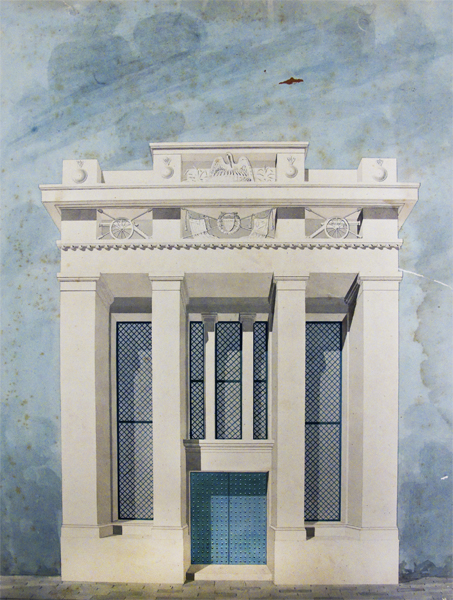Charles and James Dakin
Louisiana architects Charles Dakin and James Dakin designed the Old State Capitol building in Baton Rouge, as well as the St. Charles Hotel in New Orleans, among other projects.

Courtesy of Louisiana State Museum
Ink and wash drawing of Arsenal, St. Peter St. (front elevation). James H. Dakin (Architect)
Among the most influential antebellum architects, James H. Dakin made a major contribution to the architecture of Louisiana, particularly in New Orleans and in Baton Rouge. Though natives of New York, James Dakin and his brother Charles formed the architectural firm of Dakin and Dakin, Architects, in New Orleans in December 1835. Working in conjunction with his brother and—after his brother’s untimely death—on his own, James Dakin designed significant Louisiana landmarks, including the Louisiana State Capitol (now known as the Old Louisiana State Capitol), the Louisiana State Arsenal, and St. Patrick’s Church.
Early Life
Born August 24, 1806, James Harrison Dakin was the son of James Dakin, Sr., and Lucy Harrison of Hudson, New York. His brother Charles Bingley Dakin was born six years later. In 1829, James Dakin apprenticed as an architect with the New York City firm of Town and Davis, then the most prominent firm in the nation. By 1832 he had been made a full partner and, as result, the firm’s name was changed to Town, Davis, and Dakin. Late in 1833, however, James withdrew from the firm to begin his solo career, which led to a number of fine Greek Revival public and commercial buildings, including the Bank of Louisville in Louisville, Kentucky, built in 1836. The Dakins’ biographer, Arthur Scully, Jr., believes that Charles was employed by his older brother following James’s separation from Town and Davis.
The Dakins made their way south in separate ways. Charles left New York with Irish-born architect James Gallier, Sr., in 1834, stopping in Mobile, Alabama, before proceeding to New Orleans. Charles Dakin and Gallier quickly established a successful practice in New Orleans, receiving commissions for two of the city’s most important public buildings, the St. Charles Hotel, built in 1835, and the Merchant’s Exchange, built a year later. Neither is extant.
Career in New Orleans
James Dakin arrived in New Orleans from Louisville on November 27, 1835. Evidently he and his younger brother rapidly made plans to form their own architectural practice, because on December 24, 1835, they signed a partnership agreement that created the firm of Dakin and Dakin, Architects. In 1836, the firm received its first major commission, for the Verandah Hotel, located across the street from the St. Charles Hotel. Both buildings were eventually lost to fire.
Charles Dakin moved to Mobile in 1836 to oversee work in that city, and in 1838 left for Europe, returning to New Orleans in April of the following year. Though the exact circumstance of his death is unknown, he died Iberville Parish in 1839 and is buried in the St. Gabriel Catholic cemetery. Architectural historian Arthur Scully, Jr., suggests that Charles may have been involved in the construction of two extant Greek Revival style plantation houses in the area, Bocage and Ashland. The most prominent family in the parish, the Bringiers, is known to have owed money to the Dakins at the time, and both houses were occupied by Bringier daughters and their husbands.
In June 1838, James Dakin was hired by the parishioners of St. Patrick’s Catholic Church in New Orleans to design their new building. He produced a superb Gothic Revival design, but was removed as the project’s architect after the church claimed, in a breach of contract suit, that certain structural work had not been executed. The church was completed by James Gallier, Sr. In 1839, James Dakin received the commission for his most important surviving work in New Orleans, the Louisiana State Arsenal, located on St. Peter Street behind the Cabildo. In spite of its small size, Dakin’s Greek Revival design appears monumental thanks to his imaginative use of square columns, with the largest columns placed at each end of the facade and smaller ones framing the entrance.
Dakin continued working in New Orleans in the 1840s, producing the design for the former Canal Bank at 301 Camp Street in 1843, and the (now demolished) University of Louisiana complex on Common Street in 1847. That same year, he received the commission for the state capitol in Baton Rouge. The castellated Gothic Revival building was completed in 1849. James Dakin died in Baton Rouge on May 13, 1852; his burial site has never been identified.
While many of James and Charles Dakins’s designs have been lost, architectural renderings survive in the collection of the New Orleans Public Library. These are not the sort of architectural drawings from which a building was constructed, but rather more formal and beautifully finished presentation pieces, designed to impress a prospective client. The drawings stand as a testament to the artistic brilliance of the brothers, especially James.
